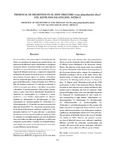
Please use this identifier to cite or link to this item:
http://ricaxcan.uaz.edu.mx/jspui/handle/20.500.11845/560Full metadata record
| DC Field | Value | Language |
|---|---|---|
| dc.contributor | 112485 | es_ES |
| dc.coverage.spatial | Norteamerica | es_ES |
| dc.creator | Mercado Reyes, Marisa | - |
| dc.creator | Angulo Castillo, Sofia | - |
| dc.creator | Clemente Sánchez, Fernando | - |
| dc.creator | Hernández Llamas, Alan | - |
| dc.creator | González Rojas, Ignacio | - |
| dc.creator | López Torres, Enrique | - |
| dc.creator | Tavizón García, Patricio | - |
| dc.date.accessioned | 2018-06-18T18:59:08Z | - |
| dc.date.available | 2018-06-18T18:59:08Z | - |
| dc.date.issued | 2010-11-16 | - |
| dc.identifier | info:eu-repo/semantics/publishedVersion | es_ES |
| dc.identifier.issn | 1405-3195 | es_ES |
| dc.identifier.uri | http://hdl.handle.net/20.500.11845/560 | - |
| dc.description | Waterfowl, such as the Mexican duck (Anas platyrhynchos diazi), are carriers of parasites that can affect the populations of different species distributed in the Zacatecano plateau, México. The objectives of the present study were to identify the species of helminths of the Mexican duck population of the Zacatecano plateau, and to compare the composition of helminths according to the sex of the ducks. Twenty four Mexican ducks (14 males and 10 females) were randomly collected in the following bodies of water: La Zacatecana dam, El Maguey pond, Matanuzka pond and the UMA pond system Los Jales of the Zacatecano Plateau. Necropsy was made in each collected duck to obtain and identify their parasites and to determine the level of parasitosis. Eight parasites belonging to four classes were identified: Trematode (3), Nematode (2), Acanthocephala (2) and Cestode (1), and corresponding to eight families: Polymorphidae (1), Hymenolepididae (1), Psilostomidae (1), Paranfistomidae (1), Echinostomatidae (1), Trychostrongylidae (1), Trichuridae (1) and Echinorhynquidae (1). The parasite with highest prevalence was Zygocotyle lunata (66.67%), and the species with lowest prevalence were Echiostomum revolutum, Capillaria sp. and Polymorphus ondatrae (4.17 % for each one). The prevalence of helminths between the sexes of Anatidae was similar (p>0.05). However, the parasitic intensity per class of helminth between sexes indicated a significant difference (p£0.05) for trematodes, acanthocephala and cestodes. The results of the present study agree with those reported by various authors for different species of ducks. | es_ES |
| dc.description.abstract | Las aves acuáticas, como el pato triguero (Anas platyrhynchos diazi), son portadoras de parásitos que pueden afectar a las poblaciones de diferentes especies distribuidas en el altiplano zacatecano, México. El presente estudio tuvo como objetivos identificar las especies de helmintos de la población de pato triguero del altiplano zacatecano, y comparar la composición de helmintos de acuerdo al sexo de los patos. Se recolectaron aleatoriamente 24 patos triguero (14 machos y 10 hembras) de en los cuerpos de agua: presa La Zacatecana, bordo El Maguey, bordo Matanuzka y sistema de bordos de la UMA Los Jales del altiplano zacatecano. En cada pato recolectado se realizó la necropsia para obtener e identificar sus parásitos y determinar el nivel de parasitosis. Ocho parásitos pertenecientes a cuatro clases fueron identificados: Trematoda (3), Nematoda (2), Acantocephala (2) y Cestoda (1), y correspondientes a ocho familias: Polymorphidae (1), Hymenolepididae (1), Psilostomidae (1), Paranfistomidae (1), Echinostomatidae (1), Trychostrongylidae (1), Trichuridae (1) y Echinorhynquidae (1). El parásito con mayor prevalencia fue Zygocotyle lunata (66.67 %), y las especies con menor prevalencia fueron Echinostomum revolutum, Capillaria sp. y Polymorphus ondatrae (4.17 % para cada una). La prevalencia de helmintos entre los sexos de anátidos fue similar (p>0.05); sin embargo, la intensidad parasitaria por clase de helminto entre sexos indicó una diferencia significativa (p£0.05) para trematodos, acantocéfalos y cestodos. Los resultados del presente trabajo concuerdan con los reportados por varios autores para diferentes especies de patos. | es_ES |
| dc.language.iso | spa | es_ES |
| dc.publisher | El Colegio de Posgraduados | es_ES |
| dc.relation | file:///C:/Users/DIRECTOR/Desktop/PRODUCCI%C3%93N/Presencia%20de%20Helmintos.pdf | es_ES |
| dc.relation.uri | generalPublic | es_ES |
| dc.rights | Atribución-NoComercial-CompartirIgual 3.0 Estados Unidos de América | * |
| dc.rights.uri | http://creativecommons.org/licenses/by-nc-sa/3.0/us/ | * |
| dc.source | Agrociencias, Vol. 44, Núm. 8, Noviembre de 2010. | es_ES |
| dc.subject.classification | BIOLOGIA Y QUIMICA [2] | es_ES |
| dc.subject.other | acantocephala | es_ES |
| dc.subject.other | aves acuáticas | es_ES |
| dc.subject.other | Cestoda | es_ES |
| dc.subject.other | Nematoda | es_ES |
| dc.subject.other | parásitos | es_ES |
| dc.subject.other | Trematoda | es_ES |
| dc.title | Presencia de Helmintos en el Patro Triguero (Anas platyrhynchos diazi) del altiplano zacatecano, México | es_ES |
| dc.type | info:eu-repo/semantics/article | es_ES |
| Appears in Collections: | *Documentos Académicos*-- UA Ciencias Biológicas | |
Files in This Item:
| File | Description | Size | Format | |
|---|---|---|---|---|
| Presencia de Helmintos.pdf | 244,17 kB | Adobe PDF |  View/Open |
This item is licensed under a Creative Commons License
